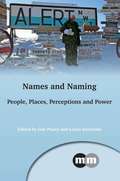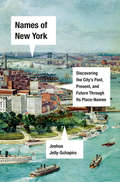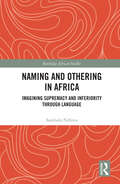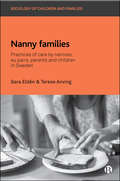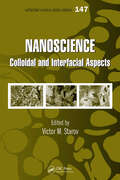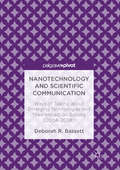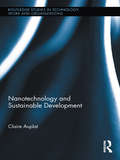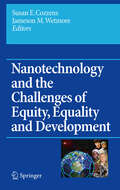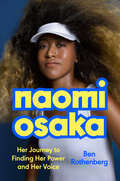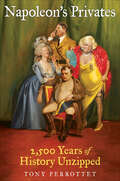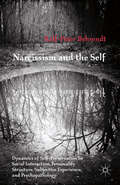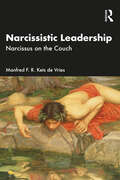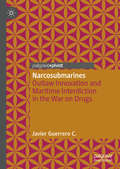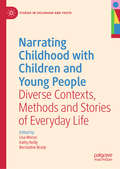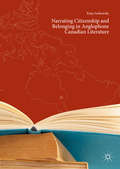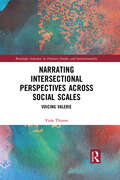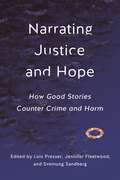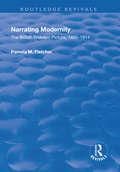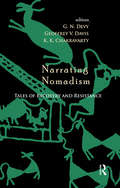- Table View
- List View
Names and Naming
by Guy Puzey Laura KostanskiThis book explores international trends in naming and contributes to the growing field of onomastic enquiry. Naming practices are viewed here through a critical lens, demonstrating a high level of political and social engagement in relation to how we name people and places. The contributors to this publication examine why names are not only symbols of a person or place, but also manifestations of cultural, linguistic and social heritage in their own right. Presenting analyses of geographically and culturally diverse perspectives and case studies, the book investigates how names can represent deeper kinds of identity, act as objects of attachment and dependence, and reflect community mores and social customs while functioning as powerful mechanisms of inclusion and exclusion. The book will be of interest to researchers in onomastics, sociology, human geography, linguistics and history.
Names of New York: Discovering the City's Past, Present, and Future Through Its Place-Names
by Joshua Jelly-Schapiro"A casually wondrous experience; it made me feel like the city was unfolding beneath my feet.&” —Jia Tolentino, author of Trick MirrorIn place-names lie stories. That&’s the truth that animates this fascinating journey through the names of New York City&’s streets and parks, boroughs and bridges, playgrounds and neighborhoods.Exploring the power of naming to shape experience and our sense of place, Joshua Jelly-Schapiro traces the ways in which native Lenape, Dutch settlers, British invaders, and successive waves of immigrants have left their marks on the city&’s map. He excavates the roots of many names, from Brooklyn to Harlem, that have gained iconic meaning worldwide. He interviews the last living speakers of Lenape, visits the harbor&’s forgotten islands, lingers on street corners named for ballplayers and saints, and meets linguists who study the estimated eight hundred languages now spoken in New York.As recent arrivals continue to find new ways to make New York&’s neighborhoods their own, the names that stick to the city&’s streets function not only as portals to explore the past but also as a means to reimagine what is possible now.
Naming No Man’s Land: Postcolonial Toponymies (Palgrave Studies in Creativity and Culture)
by Paul CarterThis book is a practice-based exploration of the politics and poetics of replacing colonial placenames with Indigenous ones. From a horizon of case-studies in Western Australia, the study develops a lively dialogue with international critical toponymy theory and with older etymological approaches to place renaming and legitimation. The author shows how renaming raises fundamental questions of meaning, reference and cross-cultural equivalence. Recognising the ‘sense of place’ values that accrue to placenames, Carter argues that placenames have a creative as well as discursive function: they are talking points that bring places into being. For this reason, to decolonize toponymy involves a postcolonial poetics. Naming No Man’s Land argues for a practical, community-shaped toponymic poetics that escapes from the binarist logic of imposition/erasure, showing that, when the principle that ‘places are made after their stories’ is followed, new creative mechanisms of co-existence can emerge. A must read for anyone engaged in postcolonial studies, creativity studies, cultural geography, sociolinguistics, historical ethnography, eco-criticism, environmental humanities, (Australian) Aboriginal studies, and related disciplines.
Naming and Othering in Africa: Imagining Supremacy and Inferiority through Language (Routledge African Studies)
by Sambulo NdlovuThis book examines how names in Africa have been fashioned to create dominance and subjugation, inclusion and exclusion, others and self. Drawing on global and African examples, but with particular reference to Zimbabwe, the author demonstrates how names are used as weapons by in-groups and out-groups in class, race, ethnic, national, gender, sexuality, religious and business struggles in society. Using Othering theory as a framework, the chapters explore themes such as globalised names and their demonstration of the other, onomastic erasure in colonial naming and the subsequent decoloniality in African name changes, othering of women in onomastics and crude and sophisticated phaulisms in the areas of race, ethnicity, nationality, disability, sexuality. Highlighting social power dynamics through onomastics, this book will be of interest to researchers of onomastics, social anthropology, sociolinguistics and African culture and history.
Naming the Witch
by James SiegelSiegel (anthropology and Asian studies, Cornell U.) explores the series of witchcraft accusations and killings in East Java that spread as the Suharto regime began to fall. Dismissing previous anthropological explanations of witchcraft and magic as inadequate, Siegel argues that witchcraft is an effect of culture, when culture is incapable of dealing with accident, death and fear of the disintegration of social and political relations. The text lacks an index. Annotation ©2006 Book News, Inc., Portland, OR (booknews.com)
Nanny Families: Practices of Care by Nannies, Au Pairs, Parents and Children in Sweden (Sociology of Children and Families)
by Sara Eldén Terese AnvingAvailable Open Access under CC-BY-NC licence Paying privately for childcare is a growing phenomenon worldwide, a trend mirrored in Sweden despite the prevalence there of publicly funded daycare. This book combines theories of family practices, care and childhood studies with the personal perspectives of nannies, au pairs, parents and children to provide new understandings of what constitutes care in nanny families. The authors investigate the ways in which all the participants experience the caring situation, and expose the possibilities and problems of nanny and au pair care. Their study illuminates the ways in which paid domestic care workers 'do' family and care; in doing so, it contributes to wider political and scientific discussions of inequalities at the global and local level, reproduced in and between families, in the context of rapidly changing welfare states.
Nanoscience: Colloidal and Interfacial Aspects (Surfactant Science)
by Victor M. StarovBringing together a prominent roster of 42 leading investigators and their teams, this volume details the wide range of theoretical and experimental knowledge that can be successfully applied for investigating nanosystems. The book provides researchers with a full examination of nano-disperse colloids, homogeneous and heterogeneous nano-structured materials (and their properties), and shelf-organization at the nano-scale. It explores non-linear lectrokinetic phenomena in nano-sized dispersions and nano-sized biological systems. It discusses application aspects of technological processes in great detail, offering scientists and engineers across all fields authoritative commentary on colloid and interface science operating at the nanoscale.
Nanotechnology and Scientific Communication: Ways of Talking about Emerging Technologies and Their Impact on Society (2004-2008)
by Deborah R. BassettThis study examines findings from a 4-year-long ethnography of communication among a research university’s community of scientists and engineers working in nanoscience and nanotechnology. It includes analysis of 20 in-depth interviews with scientists and engineers from 18 different disciplines self-identified as working in nanoscale science and engineering. Using multiple methods of inquiry, including fieldwork, interviews, and textual analysis, elements of a shared speech code are presented, each of which indicate culturally distinctive understandings of psychology, sociology and rhetoric. In particular, the interview data addresses questions such as “What kind of person is a scientist?” “What is the role of science in society?” and “What is the role of communication in science?” This book will appeal to readers interested in science and society, scientific communication, and ethnography of communication.
Nanotechnology and Sustainable Development (Routledge Studies in Technology, Work and Organizations)
by Claire AuplatPublic institutions, academic researchers and financial analysts among others hail nanotechnologies as one of the most promising sectors of social and economic development. Calculations predict that it will become a trillion euro industry by 2015 and that it will bring about economic change of at least the same magnitude as the industrial revolution. Nanotechnology is recent, younger by some thirty years than biotechnology, but it appears at a point in time in human history where there is a convergence between the globalization of access to information and increasing awareness of the importance of sustainable development. Nanotechnology and Sustainable Development explores the ways in which this convergence leads to a change in the management of innovation – and ultimately a reshaping of technological democracy. The scope of the study is global, with a particular focus on Europe and the United States, utilizing several case studies of stakeholders including entrepreneurs, commentators, end users, scientists, and policy makers.
Nanotechnology and the Challenges of Equity, Equality and Development
by Susan E. Cozzens Jameson WetmoreNanotechnology is enabling applications in materials, microelectronics, health, and agriculture, which are projected to create the next big shift in production, comparable to the industrial revolution. Such major shifts always co-evolve with social relationships. This book focuses on how nanotechnologies might affect equity/equality in global society. Nanotechnologies are likely to open gaps by gender, ethnicity, race, and ability status, as well as between developed and developing countries, unless steps are taken now to create a different outcome. Organizations need to change their practices, and cultural ideas must be broadened if currently disadvantaged groups are to have a more equal position in nano-society rather than a more disadvantaged one. Economic structures are likely to shift in the nano-revolution, requiring policymakers and participatory processes to invent new institutions for social welfare, better suited to the new economic order than those of the past.
Nanotechnology, Governance, and Knowledge Networks in the Global South
by Marcela Suárez EstradaThe seemingly unlimited technological potential of nanotechnology brings with it new practices of governance, networking, and exercising power and agency. Focusing on scholars in the Global South, this text covers nanotechnology discourses, imaginaries, and materialities as they circulate and interact within governance knowledge networks. Rather than adapt their actions to existing governance mechanisms and science, technology, and innovation policy, scientists use the imaginary of nanotechnology to create new symbolic and material incentives, thus shaping its governance. By tracing the constantly shifting asymmetries of knowledge and power, the book offers fresh insights into the dynamics of knowledge networks.
Nanotechnology-COVID-19 Interface (SpringerBriefs in Applied Sciences and Technology)
by Devasena T.This book highlights the role of nanotechnology concepts in the management of COVID-19 pandemic. The book covers different aspects of the causative agent SARS CoV2 (Severe Acute Respiratory Syndrome Coronavirus-2) and the COVID-19 pandemic with a special emphasis on nanotechnology. It discusses the origin and history of SARS CoV2 and the outbreak of COVID-19 and highlights the geographical mutations in the SARS CoV2 virus genome, providing information about the structural features, antigenicity and the life cycle of SARS CoV2. The book provides an insight into nanotechnology–virology interface and explains how nanomaterials link the gap between the vital phases of SARS CoV2 life cycle and the four modalities of COVID-19 management viz sensing/diagnosis, therapy, prevention and self-protection. Further, the existing and promising diagnostic tools for detection of COVID-19 are discussed with an emphasis on nano PCR, nanoimmunosensors, biobarcode assay and point of care approach and also describe the nanoparticles involved in the CT imaging of lungs and SFHI (Spatial Frequency Hetrodyne Imaging) for diagnosis of SARS COV2 infection. The book concludes with details about translational medicine and explains the types of SARS CoV2 vaccines, stages of COVID-19 vaccine development and possible nanovaccines for COVID-19, followed by the description on biopharmaceutical companies involved in the production of SARS CoV2 vaccines.
Naomi Osaka: Her Journey to Finding Her Power and Her Voice
by Ben RothenbergA deeply reported, revealing biography of tennis phenomenon and activist Naomi Osaka, telling the untold story behind her Grand Slam-winning career, her headline-making advocacy for racial justice and mental health, and the challenges of a life in the international spotlight. Naomi Osaka is everywhere, but how did she get there? Most tennis fans were introduced to Naomi Osaka as they watched her win the 2018 US Open final in an unforgettably controversial and dramatic victory over her idol, Serena Williams. Since then, Osaka has galvanized the tennis world--and gained attention across the culture--not only by winning three more Grand Slams, but by finding her voice. Her extraordinary talent and unique blend of power and vulnerability have propelled her to the top of her sport and onto the front page of newspapers and magazines worldwide. She became the highest-paid female athlete in history and one of the most discussed, at the cultural crossroads on myriad social issues. But until now, the story of the Haitian Japanese American Osaka family&’s journey across the world to follow their tennis dreams—and how their youngest daughter found her power off the court—has remained little known. It is a story unlike any other, and Ben Rothenberg&’s biography not only shows where Osaka came from but also where she's going as she returns to competitive tennis after a year on maternity leave. Through a riveting exploration of the ways Osaka has changed the game on and off the court, Rothenberg details the incredible impact Osaka has had in the arenas of sports, media, business, social justice, and mental health.
Napoleon's Privates: 2,500 Years of History Unzipped
by Tony PerrottetWhen Tony Perrottet heard that Napoleon's "baguette" had been stolen by his disgruntled doctor a few days after the Emperor's death, he rushed out to New Jersey. Why? Because that's where an eccentric American collector who had purchased Napoleon's member at a Parisian auction now kept the actual relic in an old suitcase under his bed.The story of Napoleon's privates triggered Perrottet's quest to research other such exotic sagas from history, to discover the actual evidence behind the most famous age-old mysteries: Did Churchill really send condoms of a surprising size to Stalin? Were champagne glasses really molded upon Marie Antoinette's breasts? What was JFK's real secret service? What were Casanova's best pickup lines? Napoleon's Privates is filled with offbeat, riotously entertaining anecdotes that are guaranteed to amaze, shock, and enliven any dinner party.
Narcissism and the Self: Dynamics of Self-Preservation in Social Interaction, Personality Structure, Subjective Experience, and Psychopathology
by R. BehrendtThe book examines how coevolved intraspecific aggression and appeasement gestures can give rise to complex social, cultural, and psychopathological phenomena. It argues that the individual's need regulate narcissistic supplies and maintain feelings of safety is the overriding determinant of human conduct and thought in mental health and illness.
Narcissism at Work
by Marie-Line GermainThis book explores the damaging effects of personality disorders in corporate leaders, particularly in regard to organizational variables including employee productivity, motivation, well-being, retention, and ultimately, the organization's bottom line. While helping employees recognize and understand the overt and covert characteristics of malignant narcissism, Narcissism at Work offers solutions and coping strategies vital for employees, industrial psychologists, human resource professionals, and organizational leaders in order to optimize business functions and increase employee well-being.
Narcissistic Leadership: Narcissus on the Couch
by Manfred F. Kets de VriesNarcissism has become a contemporary pandemic that seems to have been normalized, accepted, and even celebrated, both in society at large and by some of our political and business leaders. In this book, world-renowned psychology and leadership thinker Manfred Kets de Vries explains this modern phenomenon and imagines how you would help the narcissist on the notional "coach’s couch."Consumerism, competitive urges, individualism, and identity politics are examples of how our present-day culture has reinforced the self-glorification that drives narcissism—this cult of the self. Although a healthy competitive spirit is part of human nature, for narcissistic people it can turn into an all-consuming character trait. They view the world almost exclusively in terms of “winners” and “losers,” and to lose is unacceptable. Unfortunately, social media seems to provide ample opportunities to magnify the competitive or narcissistic disposition present in all of us.Starting with an in-depth discussion of the ancient myth of Narcissus, the various shapes in which narcissism expresses itself are highlighted. Subsequently, taking individual and group perspectives, various strategies for how to manage narcissistic people are explored. Using case examples of interpersonal and group approaches to change, concepts such as the working alliance, the emotional seesaw, the grey rock approach, boundary management, Socratic questioning, the sandwich tactic, and the need to be empathic are introduced. Also, referring to change in a group setting, the importance of the psychological dynamics of the group-as-a-whole is presented.Narcissistic Leadership offers a unique and original approach to exploring the ramifications of narcissistic leadership and will be of interest to the general reader as well as the key audiences of organizational leaders, psychoanalysts, coaches, psychotherapists, sociologists, and social psychologists.
Narcosubmarines: Outlaw Innovation and Maritime Interdiction in the War on Drugs
by Javier Guerrero C.This book is about the encounters of Colombian drug smugglers and the Colombian Navy, both in the open seas and along coastlines. Javier Guerrero C. specifically examines the technologies involved in the War on Drugs, such as the narcosubmarines and patrol boats, the knowledge required to transport drugs and the knowledge required to stop the illicit flows. The author presents compelling new evidence for advancing an understanding of technological innovation in antagonist contexts, as well as the symbiotic and co-evolutionary character of the process of technological innovation in the War on Drugs. This book will appeal both to practitioners and scholars interested in the War on Drugs and the production of technologies in outlaw contexts.
Narrating Childhood with Children and Young People: Diverse Contexts, Methods and Stories of Everyday Life (Studies in Childhood and Youth)
by Lisa Moran Bernadine Brady Kathy ReillyThis volume draws together scholarly contributions from diverse, yet interlinking disciplinary fields, with the aim of critically examining the value of narrative inquiry in understanding the everyday lives of children and young people in diverse spaces and places, including the home, recreational spaces, communities and educational spaces. Incorporating insights from sociology, geography, education, child and youth studies, social care, and social work, the collection emphasises how narrative research approaches present storytelling as a universally recognizable, valuable and effective methodological approach with children and young people. The chapters points to the diversity of spaces and places encountered by children and young people, considers how young people ‘tell tales’ about their lives and highlights the multidimensionality of narrative research in capturing their everyday lived experiences.
Narrating Citizenship and Belonging in Anglophone Canadian Literature
by Katja SarkowskyThis book examines how concepts of citizenship have been negotiated in Anglophone Canadian literature since the 1970s. Katja Sarkowsky argues that literary texts conceptualize citizenship as political “co-actorship” and as cultural “co-authorship” (Boele van Hensbroek), using citizenship as a metaphor of ambivalent affiliations within and beyond Canada. In its exploration of urban, indigenous, environmental, and diasporic citizenship as well as of citizenship’s growing entanglement with questions of human rights, Canadian literature reflects and feeds into the term’s conceptual diversification. Exploring the works of Guillermo Verdecchia, Joy Kogawa, Jeannette Armstrong, Maria Campbell, Cheryl Foggo, Fred Wah, Michael Ondaatje, and Dionne Brand, this text investigates how citizenship functions to denote emplaced practices of participation in multiple collectives that are not restricted to the framework of the nation-state.
Narrating Intersectional Perspectives Across Social Scales: Voicing Valerie (Routledge Advances in Feminist Studies and Intersectionality)
by Viola ThimmThis book presents a guide to researching intersectionality. Clear and jargon-free, this book introduces a narrative-driven, scalar, and polyvocal approach to the antiracist–feminist framework. Thimm shows students how intersectionality can be used as a methodology, especially in the analysis of multiple ‘identities’. This text considers complex social inequalities as parallel to one another – not only gender, race, class, and age, but also ethnicity, sibling seniority, religion, or educational attainment. Readers will learn how to investigate, in a methodologically structured way, the interwoven realities of life for different people and population groups simultaneously permeated by marginalization and dominance. With multiple-social-scale analysis and deep discussion of how to conduct data collection, evaluation, and write-up, this book will be of interest to students, early-career scholars, and faculties teaching undergraduate and graduate courses in women’s, gender, queer, and ethnic studies. Courses in anthropology, sociology, political science and, beyond that, engaged research on how people are marginalized or privileged given their axes of identification, will also find the book an invaluable resource.
Narrating Justice and Hope: How Good Stories Counter Crime and Harm
by Sveinung Sandberg Lois Presser Jennifer FleetwoodThe power of storytelling in troubling timesViolence, pain and punishment dominate portrayals of social problems but the reality is more complex. In the world of actual people and experience, other, more hopeful stories are told in relation to crime and harm: narratives of justice, cooperation, kindness, and redemption. Narrating Justice and Hope examines the rich potential for narratives to do good in the context of interpersonal harm and the devastating social conditions of the present moment–including climate crisis, political polarization, and interconnected systems of inequality. Featuring a stellar list of contributors from across the globe, this volume asks: How do people produce good stories in the context of these harms? What types of narratives will create lasting social change? What does it take to tell good stories?Each chapter examines subjects ranging from the success stories of formerly incarcerated people, women speaking out about sexual violence, and young climate activists. Throughout Narrating Justice and Hope, stories and storytelling thwart trouble, foster healing and connection, and envision better futures. The collection also grapples with critical issues including the nature of good, the performative nature of storytelling, and the hazards of exploiting subjugated people’s stories. With chapters from a number of well-known scholars, this volume will be an important contribution for sociology, criminology, and legal scholars.
Narrating Love and Violence: Women Contesting Caste, Tribe, and State in Lahaul, India
by Himika BhattacharyaNarrating Love and Violence is an ethnographic exploration of women’s stories from the Himalayan valley of Lahaul, in the region of Himachal Pradesh, India, focusing on how both, love and violence emerge (or function) at the intersection of gender, tribe, caste, and the state in India. Himika Bhattacharya privileges the everyday lives of women marginalized by caste and tribe to show how state and community discourses about gendered violence serve as proxy for caste in India, thus not only upholding these social hierarchies, but also enabling violence. The women in this book tell their stories through love, articulated as rejection, redefinition and reproduction of notions of violence and solidarity. Himika Bhattacharya centers the women’s narratives as a site of knowledge—beyond love and beyond violence. This book shows how women on the margins of tribe and caste know both, love and violence, as agents wishing to re-shape discourses of caste, tribe and community.
Narrating Modernity: The British Problem Picture, 1895-1914 (Routledge Revivals Ser.)
by Pamela M. FletcherThis title was first published in 2003. Problem pictures were very popular during the Edwardian period. These pictures invited multiple interpretations of modern life and were often slightly risque. Pamela Fletcher explores how these works of art engaged with questions of gender, sexuality and identity during their heyday.
Narrating Nomadism: Tales of Recovery and Resistance
by G. N. Devy; Geoffrey V. Davis; K. K. ChakravartyNarrating Nomadism provides an unflinching account of ethnic groups and nomadic communities across the world that were branded as ‘criminal’ during colonial times. It explores the tragic effect of the new identity imposed on them, the traumatic survival of these communities and cultures, and the creative expression of this experience in their arts and literature in the form of resistance. Presenting specific contexts and locations of cultural devastation in history, the volume traces colonial social imagination as such, showing how the grossly misperceived non-sedentary communities in the colonies were subjected to the mission of ‘settling’ them. The essays presented here document these alternative histories from perspectives ranging from literary criticism and art history to ethnography and socio-linguistics, highlighting in what ways different nomadic communities negotiate discrimination and challenge in contemporary times, while finding remarkable convergence in their local histories and collective testimonies.This anthology opens up a new area in postcolonial studies as well as cultural anthropology by bringing the viewpoint of marginalized communities and their cultural rights to bear upon history, society and culture. It places an activist’s ‘view from below’ at the centre of literary interpretation, engages with oral history more substantially than folklore studies usually do, and brings together several historical narratives hitherto unexplored. This will be essential for students of anthropology, sociology, cultural studies, history, linguistics, post-colonial studies, literature and tribal studies, as well as the general reader.
